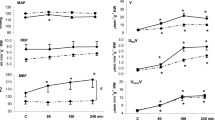Abstract
FOLLOWING the demonstration that diuresis and natriuresis, caused by blood volume expansion with iso-oncotic infusions in dogs, are similar in denervated and innervated kidneys1, it was logical to attempt the direct demonstration by crossed perfusion of a humoral effector mechanism. This undertaking was preceded by the report of Mills et al.2 that diuresis and natriuresis produced by iso-oncotic infusions in dogs could not be prevented by pitressin and mineralocorticoid administration. In the description by de Wardener et al.3 of complicated cross-perfused whole-animal preparations, as well as of isolated kidney perfusions, evidence was advanced for the operation of a natriuretic material following large saline infusions in dogs. Cort and Lichardus4, using carotid occlusion in the cat, have shown that a resulting natriuresis, presumed to be due to blood volume redistribution, could be elicited in a second cat by transferred blood. This experiment offered direct evidence of a natriuretic substance by a bioassay procedure in which the stimulus itself could not have influenced the test animal. A large amount of early work led Homer Smith5 to deduce the existence of a natriuretic system other than the mineralocorticoid mechanism for regulation of sodium metabolism. Recently, evidence has been accumulating, in particular from the work of Levinsky, Hector and Berliner et al.6–8, that expansion of the extracellular fluid volume with saline can decrease renal tubular sodium reabsorption in circumstances where neither change in mineralocorticoid levels nor in glomerular filtration rate can explain the effect.
Similar content being viewed by others
References
Pearce, J. W., and Sonnenberg, H., Canad. J. Physiol. Pharmacol., 43, 211 (1965).
Mills, I. H., de Wardener, H. E., Hayter, C. J., and Clapham, W. F., Clin. Sci., 21, 259 (1961).
de Wardener, H. E., Mills, I. H., Clapham, W. F., and Hayter, C. J., Clin. Sci., 21, 249 (1961).
Cort, J. H., and Lichardus, B., in Hormones and the Kidney, edit. by Williams, P. C. (Academic Press, London, 1963).
Smith, H. W., Amer. J. Med., 23, 623 (1957).
Levinsky, N. G., and Lalone, R. C., J. Clin. Invest., 42, 1261 (1963).
Rector, F. C., Van Giesen, G., Kiil, F., and Seldin, D. W., J. Clin. Invest., 43, 341 (1964).
Dirks, J. H., Cirksena, W. J., and Berliner, R. W., J. Clin. Invest., 44, 1160 (1965).
Sonnenberg, H., and Pearce, J. W., Amer. J. Physiol., 203, 344 (1962).
Lichardus, B., and Pearce, J. W., Fed. Proc., 24, 2, 404 (1965).
Author information
Authors and Affiliations
Rights and permissions
About this article
Cite this article
LICHARDUS, B., PEARCE, J. Evidence for a Humoral Natriuretic Factor released by Blood Volume Expansion. Nature 209, 407–409 (1966). https://doi.org/10.1038/209407a0
Issue Date:
DOI: https://doi.org/10.1038/209407a0
- Springer Nature Limited
This article is cited by
-
Atrial natriuretic hormones — Thirty years after the discovery of atrial volume receptors
Klinische Wochenschrift (1986)
-
Volume regulation in renal insufficiency caused by a decrease in mass of the renal parenchyma
Bulletin of Experimental Biology and Medicine (1982)
-
Antinatriferic activity in human plasma following acute and chronic salt-loading
Kidney International (1977)
-
Urinary sodium and calcium in various dog models and relationship to endogenous plasma glucagon
Urological Research (1977)





